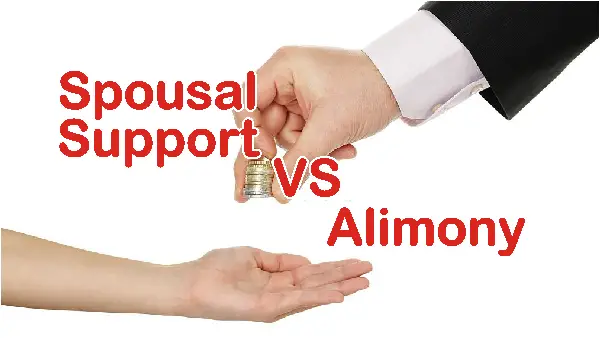
If you’re going through a divorce, one of the million thoughts on your mind is undoubtedly the difference between spousal support and alimony.
The question of whether one spouse should have to pay money to the other on a regular basis frequently arises in the minds of couples going through divorce proceedings.
Because of this financial burden, many spouses want to be clear of the term spousal support vs alimony and what it actually entails, lest they get into an unbearable financial burden.
What is the Difference Between Spousal Support and Alimony?
There is no distinction between spousal support and alimony. They are interchangeable and have the same meaning. Alimony though is an archaic phrase that refers to men financially sustaining the lifestyles of their former wives.
Spousal support, on the other hand, has nothing to do with gender. It denotes a spouse who has the financial means to “maintain” the other partner after a divorce. Instead of gender roles, spousal support focuses on money and earning capacity.
Alimony was also linked to ‘fault’ in several states. If one spouse was “at fault” for the divorce, the court may be more likely to grant alimony because the “innocent” partner bore the brunt of the at-fault partner’s wrongdoing.
What is Spousal Support Meaning?
While they signify the same thing, spousal support is a more gender-neutral term. Husband or wife are not referenced in the definition. However, it integrates the concept of a payment from one former spouse to the other for a set period of time following the divorce.
With the alterations in divorce legislation, the spousal support definition felt like a better phrase to describe financial support amongst divorced spouses. Nonetheless, most people keep referring to spousal support as alimony.
A Quick History of Alimony

History of Spousal Maintenance
Alimony is derived from the Latin word ‘alere’, which translates “to feed.” And it’s fitting, given that this support system was designed to help a wife after a divorce or separation: to feed the family when the primary financial earner of the household is not around.
For one thing, alimony used to be the primary means of supporting a divorced woman, as it was more typical for men to work outside the home while women cared for the home and children.
The assumption was that because women were not earning an income and, in many cases, had given up their potential to do so by working at home, it’d be incredibly hard for them to subsist on their own after a divorce.
Consequently, the court ordered the ex-husband, who gained from his ex-wife’s unemployment status, to provide her with a monthly alimony payment. This could lead to confusion regarding spousal support and alimony.
How Alimony Works
The types of alimony are clearly defined by the laws governing divorce. There’s “temporary” spousal maintenance, which is a maintenance order that a court will impose while the divorce proceedings are in progress (by agreement or litigation).
Permanent (or long-term) spousal support, on the other hand, is more complicated and depends on a number of variables, none of which are easy to predict. If you are considering paying or receiving spousal support, you should think about your alternatives carefully.
The length of support orders (or agreements) and the monthly amount are determined by a variety of criteria. Permanent does not always mean eternal; it usually implies until the situation changes, such as when the recipient no longer requires assistance, the paying spouse is unable to provide assistance, or the agreed-upon term expires.
Recent Changes in Spousal Support Laws
Spousal support has recently become more complex. Spousal support used to be tax-deductible for the paying spouse and taxable for the receiving spouse on a federal level.
However, after a component of the Tax Cuts and Jobs Act of 2017 came into force in 2019, the federal deduction for spousal support was abolished (though it remains in force at the state level if certain conditions are met), and payments are no longer taxable to the receiving partner.
How is Spousal Support Determined?
As previously stated, a variety of criteria influence which spouse must pay spousal support and how much they must pay. Whoever has to pay, just needs to do so, possibly by arriving at the figure using a spousal support calculator.
Some of these criteria are:
- The duration of the marriage
- Standard of living during the marriage
- Arrangements for work during the marriage
- Whether one spouse gave up earning potential, wealth, or educational possibilities to help the other spouse achieve any of the aforementioned goals
- Both parties’ health status
- Whether there was domestic violence in the past.
As each family situation is different, there are many additional considerations that courts use to examine and weigh alimony. The judge, in consultation with the parties and their attorneys, must determine a spousal support scheme that is equitable to all parties.
Who Can Seek Alimony?

Alimony After 3 Years of Marriage
Spousal support or alimony is typically sought by the spouse who has a lower financial situation. The gender of the spouse doesn’t matter – a man can seek for, and get alimony; so also a woman.
During a legal separation, divorce, domestic abuse lawsuits, and annulments, a person may seek spousal support. Spouses, domestic partners, same-sex spouses, and former spouses are all eligible for spousal support.
Based on the facts of the case, a court may award interim, long-term, or permanent spousal support. The amount of spousal support is determined by a variety of criteria. Whatever happens, ensure you look out if your spouse is interested in how to avoid paying spousal support.
How Long Does Spousal Support Last?
Depending on the type of spousal support awarded or agreed, expect the payment to last anything from one year onwards. It’s typically a fraction of the length of the marriage.
Marriages that lasted less than three years however may not get much, if any alimony. On the other hand, marriages that lasted twenty years and above will receive substantial alimony order.
The threshold for longevity is ten years, which is a common factor in determining how long spousal support last. Click here to learn more about the duration of alimony.
Private Agreements Recognizing Alimony
The importance of safeguarding and respecting a person’s right and freedom to enter into an agreement with others is recognized in some state alimony laws and public policy.
So, how do you tell the difference between court-ordered and contractual support payments? Alimony is a legal obligation that is subject to judicial enforcement procedures.
If the court had the jurisdiction to make alimony orders, for example, someone who defaulted court-ordered alimony in accordance with the order could face prison time for contempt of court.
Contractual alimony, on the other hand, establishes a contractual obligation to pay alimony that is not enforceable as a court order. Rather, if a contractual alimony provision is broken, the non-breaching spouse has the right to sue their ex-partner in court for damages.
A claimant can seek the court to use contempt proceedings to enforce a breach of contract judgment. As a result, judicial enforcement methods such as contempt of court can be used to enforce a spousal maintenance duty meant to provide a limited amount of financial assistance.
This assistance is typically meant to help a spouse become self-supporting. A private alimony arrangement, on the other hand, gives the supported spouse the right to sue for damages and other legal claims if the contract is broken.
Spousal Support vs Alimony Conclusion
As outlined above, there is no difference between spousal support and alimony. While the former is a more recent term typically denoting gender neutrality in spousal maintenance, the latter was coined to mean the monetary support a man makes to his ex-wife after a divorce.
Be mindful not to confuse this topic with alimony vs child support.




